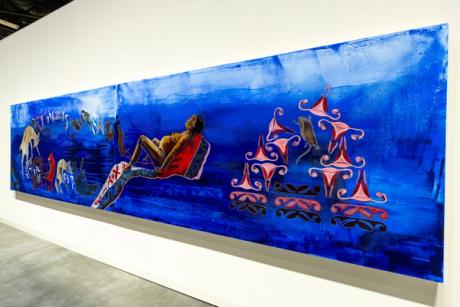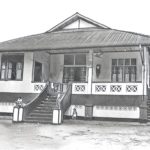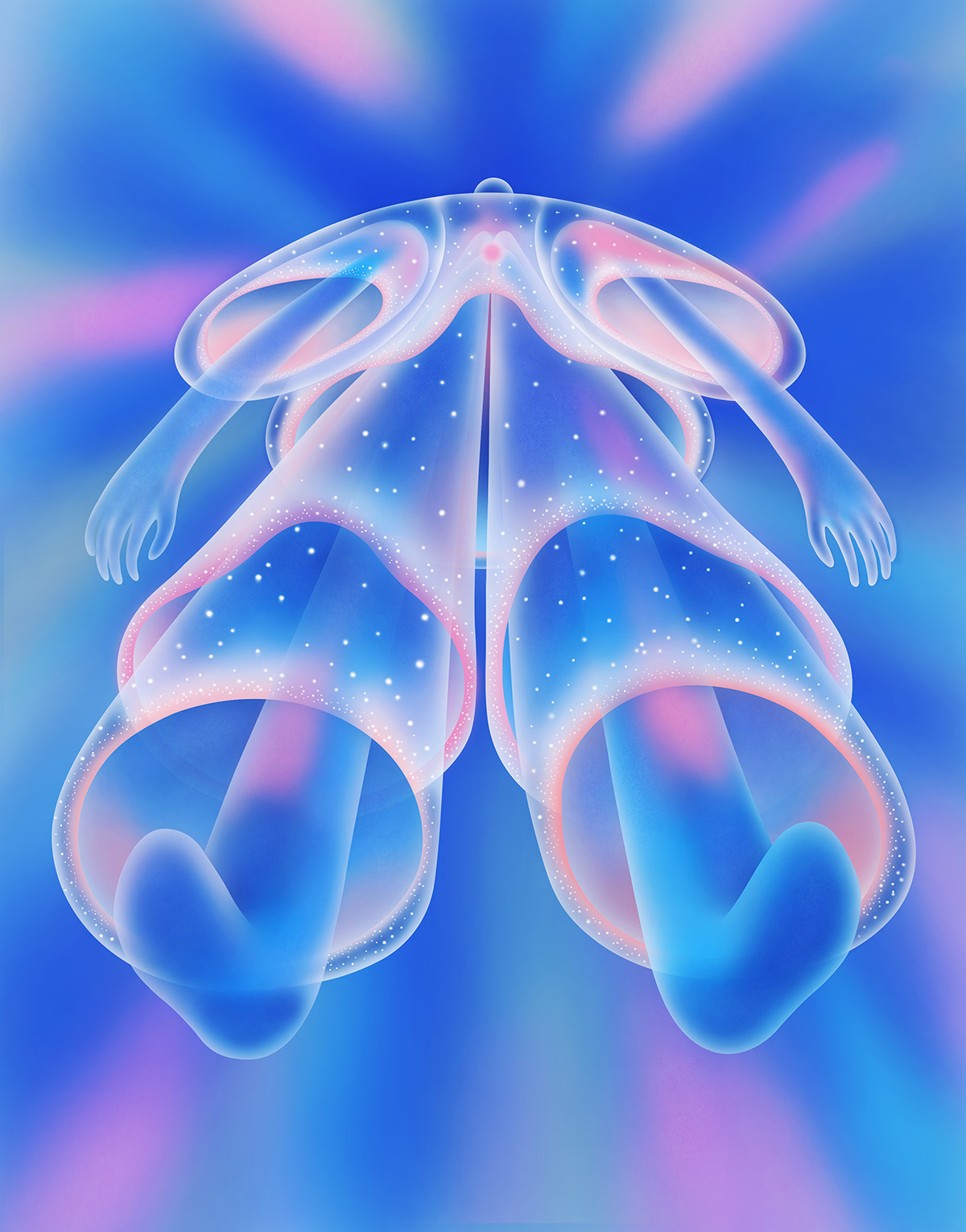Too fragile to handle it without
2022 - Drawing & Print (Drawing & Print)
Framed: 36.51 x 48.58 cm
Tirdad Hashemi
The Blue Poisoning series , reveals the outcome of artist Tirdad Hashemi’s weary and depressed days in the winter of 2022, following their second migration from Paris to Berlin. The color blue expresses the feelings of sadness and loneliness felt by the artist in the frozen Berlin cold. In the drawing, lonely and tormented bodies seem to struggle to live; despite their suffering, they still hope. The artist’s playful expression in the use of long, soft, and free lines. The use of motifs such as water, watering cans or plants create an unreal and satirical world. The turbulent composition of the works, with their naive and playful figures are opposed to the feeling of sadness that emerges. Often filled with white space, the frame stages the daily life of characters drawn as if they were unbalanced or disproportionate: stretched, suspended, inclined. Thus, Hashemi does not compose a pantheon of images but a flow of varied stylistic representations constantly reworking the material of their biography. In this drawing, titled Too fragile to handle it without , blue (in the form of water) also suggests the idea of life and rebirth. The plant on the chest of drawers tries to spread its roots in the space around it, as the artist does in the new places they live. The lines are agitated; the colors are frank and bright. The clumsiness is assumed. Scribbled in urgency, Hashemi’s drawings reflect their impetuosity and express the contradictory effects they experience. In oil pastel, colored pencil or paint, their drawings unfold on loose sheets the diary of their life, their memories and their fantasies intertwined; a diary that they maintain in the circuit of the intimate.
Leaving Iran in 2017, Tirdad Hashemi now cultivates perpetual movement, between their hometown of Tehran, Istanbul, Paris, and Berlin. They started painting in order to express things that cannot be formulated verbally. Hashemi’s representations are based on everyday life, their own, and that of their friends in exile. They have chosen the medium of drawing or small format paintings in order to be able to create wherever they are without any material constraints. Hashemi’s work expresses the singularity and the harshness of their mutable lifestyle. Emotional and political stories overlap in their works that give form to depression, the homesickness of their exiled friends, and melancholy. For Hashemi, intimacy is a collective matter, meant to be shared. They have made incompleteness a modality of their style, their drawings often being sketched quickly and as if left to their own fate. Hashemi’s practice has since expanded to include hands other than their own; while in residence at the B.L.O. studio in Berlin, they began collaborating with Soufia Erfanian.
Colors:
Related works sharing similar palette

© » KADIST
Eleanor Antin
1973Comprised of fifty-one photographic postcards, Antin’s 100 Boots is an epic visual narrative in which 100 black rubber boots stand in for a fictional “hero” making a “trip” from California to New York City...

© » KADIST
Alexis Smith
1995In 8 Ball Surfboard (1995),Alexis Smith combines her long-term interests in California culture and conceptual assemblage...

© » LENS CULTURE
Living in the Transition - Photographs by Shunta Kimura | Text by Magali Duzant | LensCulture Award winner Living in the Transition Traveling through Gabura Union in Bangladesh, Shunta Kimura documents impact, adaptation, and resilience in his quiet photographs of everyday life on the frontlines of rapid climate change...

© » ARTNEWS RETROSPECTIVE
A Jacob Lawrence Expert on a Profile of Him from ARTnews’s Archives – ARTnews.com Skip to main content By Alex Greenberger Plus Icon Alex Greenberger Senior Editor, ARTnews View All January 24, 2020 1:35pm George Chinsee Jacob Lawrence (1917–2000) was one of the deftest documentarians of African-American life in the United States, and over the next few years, people across the country will get a chance to see one of his greatest series of paintings, “Struggle: From the History of the American People” (1954–56), united in full for the first time...

© » THEARTNEWSPER
Political art stays peripheral at Art Basel in Miami Beach Art market Museums & heritage Exhibitions Books Podcasts Columns Technology Adventures with Van Gogh Search Search Art Basel in Miami Beach 2023 news Political art stays peripheral at Art Basel in Miami Beach Fair’s stands largely remain neutral despite multiple hot-topic issues in the world today Gareth Harris and Tim Schneider 9 December 2023 Share Julie Buffalohead’s Our Bodies Our Choice , in the Meridians section, references wide-ranging injustices against Native Americans Photo: Liliana Mora Should art engage with politics or offer an escape from politics? This is the question dealers, artists and collectors have tended to face in the run-up to Art Basel in Miami Beach from its very first outing...

© » ARTS EQUATOR
Orang Phebien: Telling the story of the Baweanese | ArtsEquator Thinking and Talking about Arts and Culture in Southeast Asia Articles Illustration: Hadi Osni August 5, 2020 Lesser known narratives involving migration in Singapore are in the spotlight with The Arts House’ latest edition of LumiNation ...

© » KADIST
Newell Harry
2015(Untitled) Nimoa and Me: Kiriwina Notations by Newell Harry brings together a litany of contemporary politics—mobilization around enduring racism, the legacies of Indigenous and independence struggle, and the prospects of global solidarity against neocolonialism and social injustice...

© » KADIST
Karen Lamassonne
1989Ventana indiscreta (Rear Window) by Karen Lamassonne takes its title from Hitchcock’s renowned 1954 classic...

© » KADIST
Prabhakar Pachpute
2014“Dark Clouds Of The Future” is a cinematographic video animation of the abandoned gold mine in Brazil, Serra Pelada (“Naked Mountain”)...

© » KADIST
Kelly Sinnapah Mary
2021Notebook 10 , l ‘enfance de sanbras (The Childhood of Sanbras) series by Kelly Sinnapah Mary is a sequel to an earlier series by the artist titled Cahier d’un non retour au pays natal (2015)...

© » KADIST
Prabhakar Kamble
2022To produce the series of sculptures collectively titled Utarand , Prabhakar Kamble relocated his studio to Kolhapur, Maharashtra, near the village where he was born into a family of daily wage earners...

© » THE JEALOUS CURATOR
Soooo, when Malcom Gladwell’s podcast network reaches out to you and says, “Hey Danielle, would you like to share part of an interview we did with Marina Abramović with your listeners”, you say, “ummm, OKAY!” I’ve put a little mini episode together, featuring a 20 minute excerpt from their show, “Talk Easy with Sam Fragoso”...







